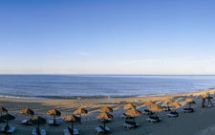Forte de Santiago
Forte de Santiago
Monuments
Located alongside the beach of Sesimbra, the Fort of Santiago formed part of the Sado estuary´s line of defence in the 17th century. In addition, defence was ensured by the Portinho da Arrábida, the São Teodósio, the Baralha and the Cabo Espichel Forts.
Completed in 1648, the project is the work of Jesuit priest João Cosmander, colonel of the guard of king João IV. Of the complex, there remains the storage quarters, the cisterns, the magazine, the former governor´s residence, the dungeons and the chapel.
Between the two towers on the northern side, the regional military government took up residence in 1712. The same space served as a summer residence to the Meninos de Palhavã, bastard sons of king João V (18th century).
The military fort was deactivated in 1832, and handed over to the Customs Authorities in 1886. In 1879, the Taxation Guard took over the barracks and still remain.
Completed in 1648, the project is the work of Jesuit priest João Cosmander, colonel of the guard of king João IV. Of the complex, there remains the storage quarters, the cisterns, the magazine, the former governor´s residence, the dungeons and the chapel.
Between the two towers on the northern side, the regional military government took up residence in 1712. The same space served as a summer residence to the Meninos de Palhavã, bastard sons of king João V (18th century).
The military fort was deactivated in 1832, and handed over to the Customs Authorities in 1886. In 1879, the Taxation Guard took over the barracks and still remain.
Contacts
Address:
Rua da Fortaleza, junto à Praia 2970 Sesimbra
Monday to Friday: 9am - 12pm / 2pm - 5.30pm; Closed Saturday, Sunday and Public Holidays.




 Explore
Explore 
 Remember and Share
Remember and Share 


